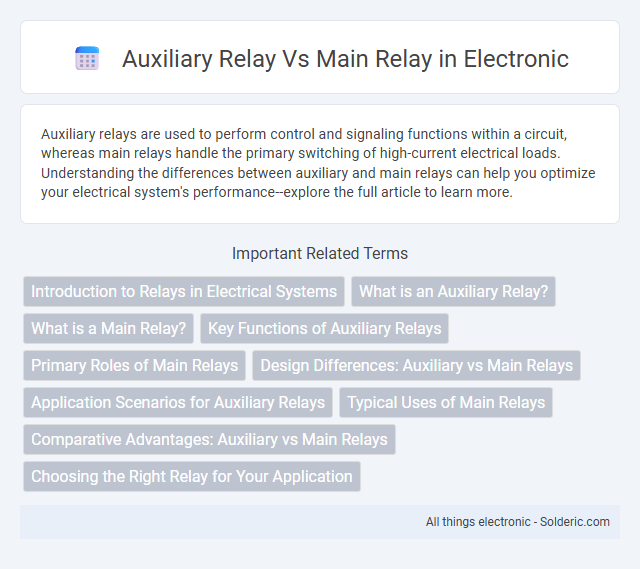Auxiliary relays are used to perform control and signaling functions within a circuit, whereas main relays handle the primary switching of high-current electrical loads. Understanding the differences between auxiliary and main relays can help you optimize your electrical system's performance--explore the full article to learn more.
Comparison Table
| Feature | Auxiliary Relay | Main Relay |
|---|---|---|
| Function | Performs secondary control tasks like signaling and interlocking | Controls the primary switching of electrical circuits |
| Load Capacity | Handles low current and voltage loads | Handles high current and voltage loads |
| Usage | Used for control and indication purposes | Used for circuit protection and main switching |
| Switching Speed | Faster due to lighter load | Slower compared to auxiliary relays |
| Contact Configuration | Multiple small contacts | Fewer, heavy-duty contacts |
| Application | Control panels, automation circuits | Power distribution, motor control |
| Coil Voltage | Typically low voltage | Can be low or high voltage depending on design |
Introduction to Relays in Electrical Systems
Auxiliary relays serve as secondary control devices that amplify or extend the switching capacity of main relays in electrical systems. Main relays function as primary control switches that directly handle high-power circuits, ensuring the safe and efficient operation of electrical equipment. Both relay types are essential for automation, protection, and precise control in complex electrical networks.
What is an Auxiliary Relay?
An auxiliary relay is an electrical device used to control a circuit by opening or closing contacts in response to a small input signal. It acts as an intermediary switch, enabling the control of high-power devices with low-power signals, improving system safety and efficiency. Your control systems benefit from auxiliary relays by providing isolation, signal amplification, and implementing complex control logic.
What is a Main Relay?
A main relay is an essential electromechanical switch used to control high-power circuits by opening and closing contacts in response to a low-power control signal. Unlike auxiliary relays, which handle secondary functions such as signaling or interlocking, the main relay directly controls the primary power flow to equipment or machinery. You rely on the main relay to safely and efficiently manage the operation of critical electrical components in industrial and automotive systems.
Key Functions of Auxiliary Relays
Auxiliary relays serve critical functions such as controlling logic operations, providing interface isolation, and enabling indirect switching in electrical circuits. They support the main relay by handling smaller currents for control signals, ensuring the main relay operates efficiently under high-power conditions. Understanding the key functions of auxiliary relays helps you design reliable and flexible control systems.
Primary Roles of Main Relays
Main relays serve as the primary switch that controls high-current circuits in automotive and industrial applications, enabling power distribution to essential components like fuel pumps and engine control units. They ensure reliable operation by handling large electrical loads and protecting sensitive parts from voltage spikes. Understanding the primary roles of main relays helps you maintain efficient and safe electrical system performance.
Design Differences: Auxiliary vs Main Relays
Auxiliary relays are typically smaller with simpler coil and contact arrangements designed for low-power control signals, whereas main relays feature larger, more robust designs capable of handling high current loads. Main relays often include heavy-duty contacts built to switch higher voltages and currents, ensuring durability in power circuits. Understanding these design differences helps you select the appropriate relay type for your specific electrical application needs.
Application Scenarios for Auxiliary Relays
Auxiliary relays are primarily used in control circuits and signal switching, providing additional contacts to support main relay operations and allowing for complex logic functions without high current loads. Main relays handle load switching in power circuits, directly controlling motors, lighting, or other electrical devices under significant current and voltage conditions. Auxiliary relays are ideal for applications requiring isolation between control and power circuits, while main relays are suited for heavy-duty power switching in industrial automation and machinery control.
Typical Uses of Main Relays
Main relays are typically used to control high-power circuits in automotive and industrial applications, serving as a switch for main electrical components such as fuel pumps, ignition systems, and cooling fans. These relays handle large currents to protect sensitive control circuits from overload and ensure reliable operation of primary vehicle or machinery functions. Your system depends on main relays for critical power management, making them essential for starting processes and overall electrical stability.
Comparative Advantages: Auxiliary vs Main Relays
Auxiliary relays provide enhanced control flexibility by handling low-power signals to operate main relays or other devices, offering precise switching with minimal wear and longer lifespan. Main relays are designed to manage high current loads directly, ensuring robust performance for powering significant electrical components but may experience faster mechanical degradation under frequent switching. Your choice depends on balancing the need for signal isolation and control simplicity against current handling capacity and durability requirements.
Choosing the Right Relay for Your Application
Selecting the right relay for your application depends on factors such as load current, switching speed, and control voltage. Auxiliary relays are best suited for low current signal switching and control circuits, providing isolation and amplification without handling high power loads. Main relays are designed to switch higher current loads directly in power circuits, making them ideal for controlling motors, heating elements, or lighting systems in industrial and automotive applications.
auxiliary relay vs main relay Infographic

 solderic.com
solderic.com